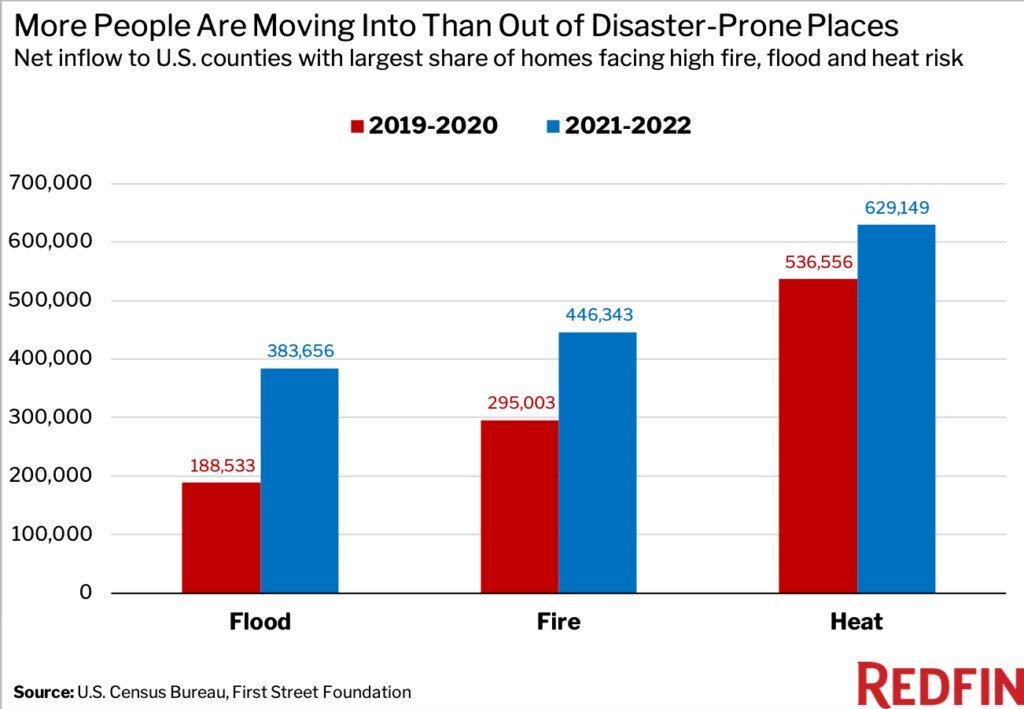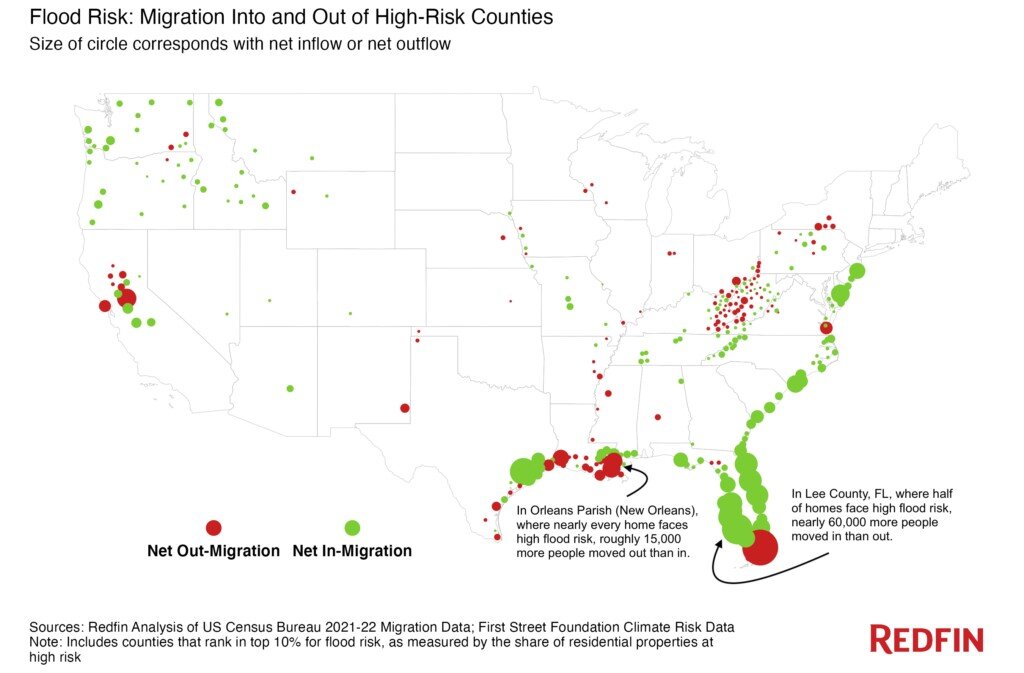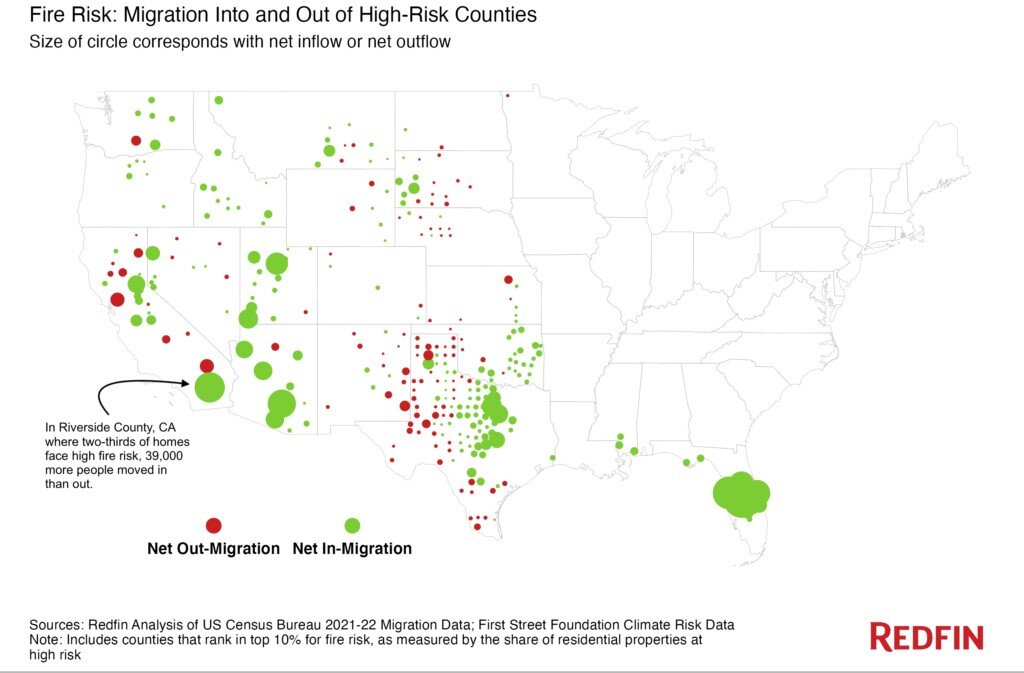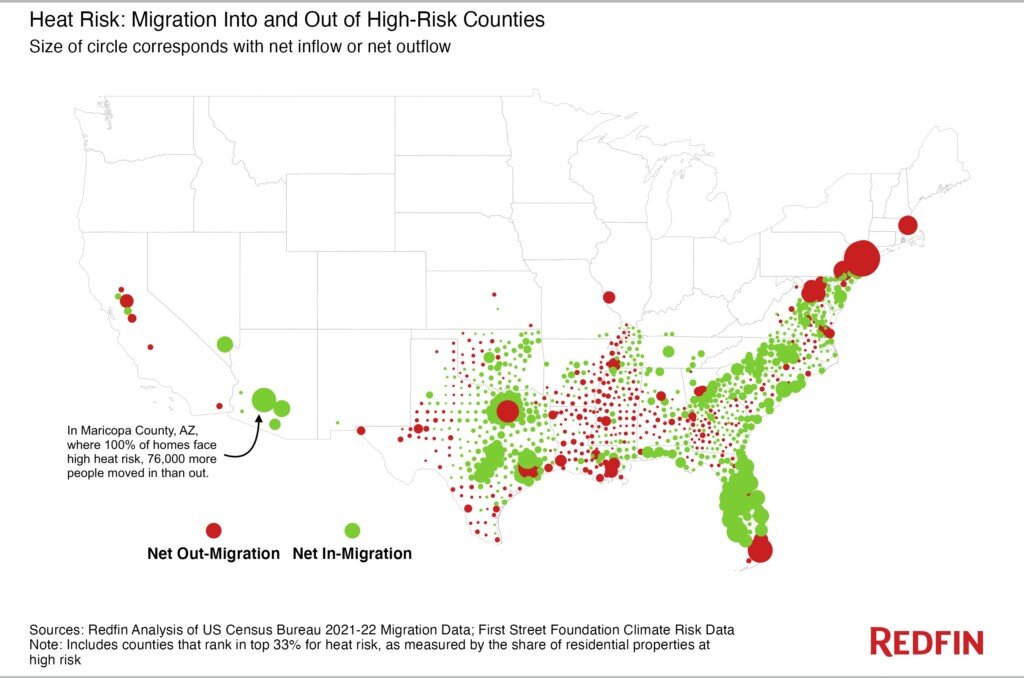Residential Real Estate News
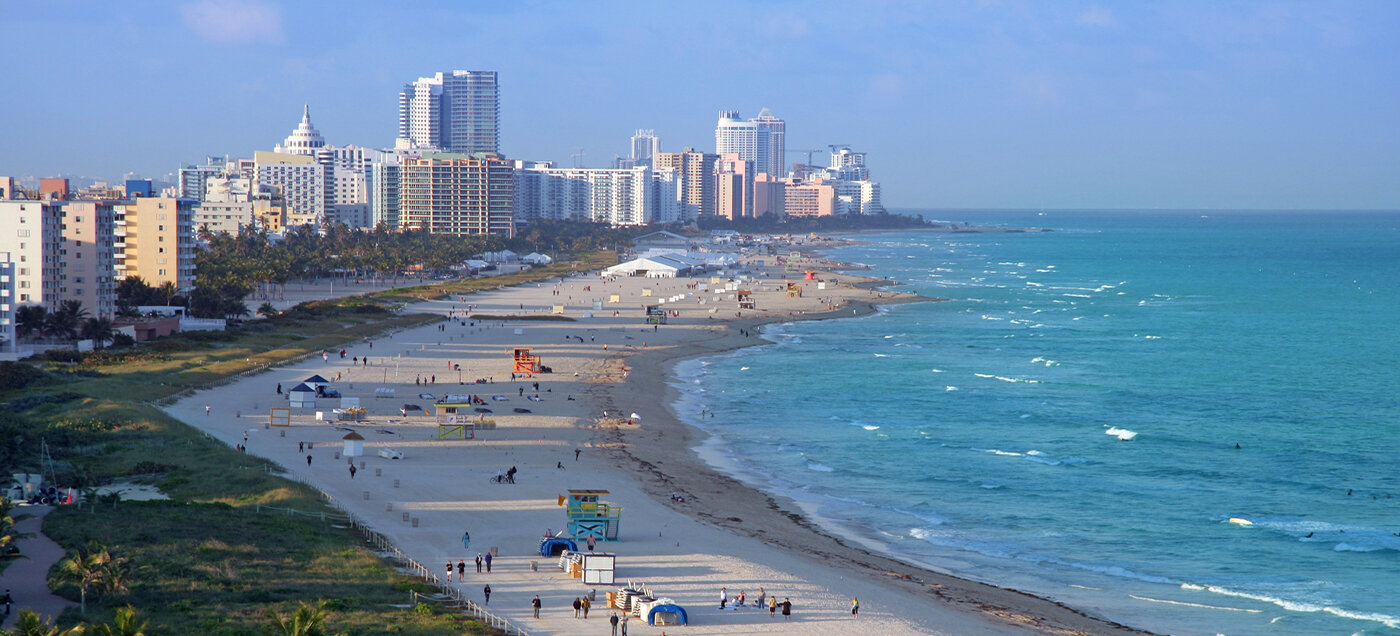
U.S. Migration to Most Flood-Prone Areas Has Doubled Since the Pandemic
Residential News » Miami Edition | By Michael Gerrity | July 25, 2023 7:29 AM ET
Based on new data from Redfin, the most flood-prone U.S. counties saw 384,000 more people move in than out in 2021 and 2022--a 103% increase from the prior two years, when 189,000 more people moved in than out.
The same trend took hold in the places most vulnerable to wildfires and heat as the pandemic homebuying boom and a housing affordability crisis pushed Americans into disaster-prone areas.
The counties with the highest wildfire risk saw 446,000 more people move in than out over the past two years, a 51% increase from 2019 and 2020. And the counties with the highest heat risk saw 629,000 more people move in than out, a 17% uptick.
This is according to a Redfin analysis of domestic migration data from the U.S. Census Bureau and climate-risk scores from First Street Foundation. Redfin analyzed the counties in the contiguous U.S. that rank in the top 10% for flood and fire risk and the top 33% for heat risk, as measured by the share of residential properties at high risk.
Remote work and record-low mortgage rates during the pandemic prompted scores of Americans to leave expensive coastal cities like San Francisco and New York for the Sun Belt in search of more affordable housing, warm weather and/or lower taxes. States including Florida, Texas and Arizona exploded in popularity despite increasing risk from storms, drought, wildfires and extreme heat.

"It's human nature to focus on current benefits, like waterfront views or a low cost of living, over costs that could rack up in the long run, like property damage or a decrease in property value," said Redfin Chief Economist Daryl Fairweather. "It's also human nature to discount risks that are tough to measure, like climate change."
Many disaster-prone areas are relatively affordable because homebuyers and renters have a larger pool of homes to choose from. America is increasingly building housing in places endangered by climate change; more than half (55%) of homes built so far this decade face fire risk, while 45% face drought risk, a separate Redfin analysis found. By comparison, just 14% of homes built from 1900 to 1959 face fire risk and 37% face drought risk. New homes are also more likely than older homes to face heat and flood risk.
"The consequences of climate change haven't fully sunk in for many Americans because oftentimes, homeowners and renters don't foot the whole bill when disaster strikes," Fairweather said. "Insurers and government programs frequently subsidize the cost of rebuilding after storms hit, and mortgages mean homeowners are ceding some risk to lenders--especially if their house goes into foreclosure after a storm. But with natural disasters intensifying and insurers pulling out of disaster-prone areas including Florida and California, Americans may start feeling a greater sense of urgency to mitigate climate dangers--especially if their home's value is at risk of declining."
Nearly half (48.7%) of people who moved in the last year believe the increasing frequency or intensity of natural disasters, extreme temperatures, and/or rising sea levels will likely impact home values in their area in the next 10 years, according to a recent Redfin survey. Still, only about 5% of people who moved in the last year or plan to move in the next year listed climate change as a reason for their relocation.
Coastal Florida Is Top Migration Destination Despite Increasing Flood Risk
In the past two years, nearly 60,000 more people moved into than out of Lee County, FL, which includes Fort Myers and Cape Coral and was ravaged by Hurricane Ian in September. That's the largest net inflow of the 306 high-flood-risk counties Redfin analyzed, and represents an increase of about 65% from the prior two years.
Half of homes in Lee County face high flood risk. Still, homebuilders continue to build and homebuyers continue to buy. The Cape Coral metro area has more than made up for the plunge in new listings caused by the storm, and home sales have also rebounded, a separate Redfin analysis found.
"Builders in Cape Coral have not stopped--they're just building like nothing happened," said local Redfin Premier real estate agent Isabel Arias-Squires. "That's largely because there's plenty of demand for new homes. Many folks who moved into Florida from the Northeast or the West during the pandemic are leaving, but they're quickly being replaced by new out-of-staters. Some people just want to be on the water no matter what, and/or they want to move here for family, weather or political reasons. The Cape is not slowing down."
People Are Leaving Storm-Prone Louisiana as Insurance Costs Soar
While people are still moving to Florida, they're leaving flood-prone Louisiana, which has among the largest concentration of high-risk homes. Nearly every home in Orleans Parish and Jefferson Parish--the areas including and surrounding New Orleans--faces high flood risk. Both saw roughly 15,000 more people move out than in over the past two years, adding to outflows from the prior two years.
"The rise in homeowners insurance rates across Louisiana is decreasing the amount of money people have to put toward buying a home, diminishing their purchasing power," said local Redfin Premier real estate agent Jes Menes. "Elevated insurance costs are also driving some landlords to increase rents, making housing more expensive for tenants."
Inland California, Utah and Arizona See Populations Swell as Fire Risk Grows
In Riverside County, CA --home to Riverside and Palm Springs--nearly 600,000 homes face high wildfire risk. That's the most among the 306 high-fire-risk counties Redfin analyzed, and represents two-thirds of the county's total homes. Nearly 40,000 more people have moved into than out of Riverside County in the past two years--the third highest net inflow of the counties Redfin analyzed and a 36% jump from the prior two years.
The Inland Empire has grown in popularity partly because it offers more affordable housing costs than coastal California cities including Los Angeles and San Francisco. Parts of Utah, Nevada and Arizona have seen their populations swell for the same reason.
In Washington County, UT, an area in the southwestern corner of Utah that includes Zion National Park and St. George, 95.5% of homes face high fire risk, and drought is also a major issue. It saw 15,000 more people move in than out over the past two years. The story is similar in Utah County, which is just south of Salt Lake City and includes Provo.
There is at least one part of the country that's seeing a net outflow of residents in the wake of wildfires. Butte County, CA is home to the town of Paradise, most of which was destroyed by the Camp Fire in 2018. It lost nearly 2,000 more people than it gained in 2021 and 2022--one of the biggest declines among the 306 counties Redfin analyzed. During the prior two years, it had a net outflow of 17,000--more than any other county Redfin analyzed.
Fairweather has her own climate migration story. She left Seattle in 2020 to escape wildfire smoke and moved to Wisconsin. It was free from smoke for the first few years she was there, but this June was hit with four days of unhealthy smoke from wildfires in Canada.
"There's nowhere to hide," Fairweather said. "Every place on planet earth will have to deal with the ramifications of climate change. The Midwest may be insulated from sea level rise, but it still faces risk from storms, heat waves and drought."
People Flock to Phoenix for Affordability, Stumbling Into Extreme Heat and Drought
In Maricopa County, AZ, home to Phoenix, 76,000 more people moved in than out during the past two years--the largest net inflow among the 1,019 high-heat-risk counties Redfin analyzed. In all of those counties, roughly 100% of homes face high heat risk.
Collin County, TX, just north of Dallas and home to Plano, saw the second biggest net inflow, at 61,000, followed by Lee County, at 57,000. Many parts of the U.S. are grappling with multiple climate risks at once. Lee County is a good example, facing high risk from both flooding and heat.
The explosion in Phoenix's population has coincided with a dire climate crisis: a lack of water. Arizona recently said it will stop issuing homebuilding permits in some parts of the Phoenix area as migration and extensive development strains limited water resources. That will cap the number of new communities that can be built in the area, which could eventually increase the cost of housing.
Still, Maricopa County gained more residents than any other U.S. county in 2022, attracting scores of remote workers from expensive coastal cities like Seattle, where the cost of living is significantly higher.
Sign Up Free | The WPJ Weekly Newsletter
Relevant real estate news.
Actionable market intelligence.
Right to your inbox every week.
Real Estate Listings Showcase
Related News Stories
Residential Real Estate Headlines
- U.S. New-Home Sales Surge in August as Mortgage Rates Ease
- Despite Increased Foreign Buyer Activity, Miami Residential Sales Dip 11 Percent in August
- California Home Sales Enjoy Modest Uptick as Mortgage Rates Ease
- U.S. Home-Flipping Profits Sink to Lowest Level Since 2008 Financial Crisis as Costs Climb
- Why the World's Rich Are Flocking to Europe in 2025
- Federal Reserve Delivers First Rate Cut of 2025 as Mortgage Relief Proves Limited
- Homebuilder Sentiment Holds Steady in U.S. as Rate-Cut Bets Lift Outlook
- U.S. Mortgage Rates Experience Sharpest Weekly Drop in Over a Year
- U.S. Foreclosures Rise for Sixth Straight Month as Affordability Pressures Mount
- Black U.S. Homeownership Rate Falls to Two-Year Low as Job Losses Mount
- Las Vegas Home Prices Flatten as Listings Surge, Sales Slow
- Cooling Miami Housing Market Sees 16 Percent Annual Sales Drop in July
- U.S. Mortgage Delinquencies Uptick in June Amid Regional Pressures
- California, Florida Top U.S. Housing Markets Most at Risk of Downturn
- 30-Year Mortgage Drops to 6.56 Percent in Late August, Lowest Since October 2024
- Investors Maintain Elevated Role in U.S. Housing Market Despite Slight Pullback
- Pending Home Sales Show Mixed Signals as U.S. Buyers Remain Cautious
- Canadian Home Sales Extend Recovery in July
- U.S. Home Sales Rise in July as Buyers Gain More Bargaining Power
- Zombie Foreclosures Edge Up Across U.S.
- 2.6 Million Homes at Wildfire Risk Across 14 Western States in 2025
- One in Five Americans Willing to Trade Personal Safety for Home Affordability
- U.S. Home Price Growth Slows as Affordability Pressures Mount in 2025
- U.S. Mortgage Rates Dip to Four Month Low in Early August
- U.S. Mortgage Applications Rise in Late July, Breaking Four-Week Slump
- Hong Kong's Housing Market Stuck in Stalemate as Bulls and Bears Face Off
- U.S. Condo Market Struggles in 2025
- U.S. Pending Home Sales Remain Sluggish in June
- Los Angeles Area Wildfires Destroyed Nearly $52 Billion in Homes Last January
- Greater Palm Beach Area Residential Sales Slip in June Amid Growing Inventory
- Economic Resilience Lifts U.S. Housing Outlook Going Forward
- New Home Sales Stagnate as Affordability Struggles Continue in America
- U.S. Housing Market Slips in June as Prices Hit New Highs
- Florida, California Continue to Reign Supreme as America's Ultraluxury Housing Markets
- Caribbean Housing Market Evolves into Global Second-Home Hotspot
- U.S. Home Sales See Highest June Cancellation Rate on Record
- Orlando Housing Market Cools in June as Listings Slide, Sales Slow
- Private Credit Surges in 2025 as Real Estate Developers Bypass Banks
- U.S. Condo Market Suffers Sharpest Price Drops in Over a Decade as Buyers Retreat
- Rising Taxes, Insurance Costs Undermine the Stability of U.S. Homeownership

